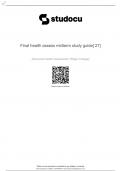lOMoARcPSD|16995810
+
A+
Final health assess midterm study guide[ 27]
Advanced health Assessment (Regis College)
Scan to open on Studocu
Studocu is not sponsored or endorsed by any college or university
Downloaded by DANIEL NDAMBIRI (ndambiridaniel20@gmail.com)
, lOMoARcPSD|16995810
+
A+
Devyn DiFronzo
June 21, 2023
NU650
Health Assess Midterm Study Guide
EXAM 1
know how the environment can impact the health assessment and strategies to create an
environment that best
know strategies to build rapport for and complete and H&P for patients, including patients from
different cultures, and developmental stages
know strategies to getting a history and establishing a relationship from challenging patients
(rambling, angry, silent, nervous, mentally ill, confused, etc)
know the three dimensions of cultural humility
know the general principles of collecting a health history: initiating the history, making transition
statements, summarizing
know the types of cognitive errors
define acute and chronic pain and know how to assess pain
know the components of a health history and what to document in each one (pay special
attention to objective vs. subjective findings)
explain how bias can impact the health history
know the process of clinical reasoning and what happens at each step
know the key social determinants of health
know the core values of medical ethics
know what is meant by non-stigmatizing language and how to use it
know the positions and techniques for the physical exam
for each vital sign, know how to take it, what the normal findings should be, and what abnormal
findings could indicate
know the seven attributes of a symptom
SKIN/HAIR
Downloaded by DANIEL NDAMBIRI (ndambiridaniel20@gmail.com)
, lOMoARcPSD|16995810
+
A+
definitions of lesion descriptions
o macule: a circumscribed flat area of change in color of the skin <1 cm in diameter (ex:
freckles, flat moles, port-wine stains, + rashes of rickettsial infections, rubella and
measles)
o patch: a circumscribed flat area of change in color of the skin > 1cm in diameter (ex:
pityriasis rosea, melasma, lentigo)
o papule: a small solid elevation of the skin < 1cm in diameter (ex: nevi, warts, lichen
planus, insect bites, seborrheic keratoses, actinic keratoses, some lesions of acne, and
skin cancers)
o plaque: a large flatter elevation of the skin, sometimes formed by papule coalescing
(psoriasis, mycosis fungoides)
o nodule: a solid elevation of the skin >1cm in diameter that usually extends into the
deeper layers (cysts, lipomas, and fibromas)
o pustule: a small circumscribed elevation of the epidermis filled with purulent fluid
(common in bacterial infections and folliculitis)
o vesicle: a small circumscribed elevation of the epidermis containing clear fluid < 1cm in
diameter (ex: characteristic of herpes infections, acute allergic contact dermatitis, and
some autoimmune blistering disorders such as dermatitis herpetiformis)
o bulla: a circumscribed elevation of the epidermis containing clear fluid > 1cm in
diameter (ex: classic autoimmune bullous diseases include pemphigus and bullous
pemphigoid)
o wheal: a circumscribed, raised lesion consisting of dermal edema and is also known as
hives or urticaria. Wheals typically last <24 hours (ex: common manifestation of
hypersensitivity to drugs; stings or bites; autoimmunity; and less commonly, physical
stimuli including temperature, pressure, and sunlight)
o tumor: Large papule or nodule; usually >1cm diameter (basal cell carcinoma, squamous
cell carcinoma, malignant melanoma)
o cyst: Semisolid lesion; various in size from several mm to several cm; may become
infected (sebaceous cyst)
o erosions (loss of epidermal or mucosal epithelium), ulcers (deeper loss of the epidermis
and at least the upper dermis), petechiae (nonblanchable punctate foci of hemorrhage),
purpura (nonblancable, raised and palpable), ecchymoses (nonblanchable, larger areas
or purpura)
secondary lesions (appear as result of changes in primary lesions):
o crust: dried exudate that may have been serous, purulent, or hemorrhagic (impetigo,
herpes zoster/late phase)
o scale: thin plates of desquamated stratum corneum that flake off rather easily (xerosis,
ichthyosis, psoriasis)
o excoriation: Shallow hemorrhagic excavation; linear or punctuate; result from scratching
(contact (irritant) dermatitis)
o lichenification: thickening of skin with exaggeration of skin creases; hallmark of chronic
eczematous dermatitis (chronic eczema)
o erosion: partial break in epidermis (herpes simplex or zoster, pemphigus vulgaris)
o fissure: linear crack in epidermis (xerosis, angular chelitis, severe eczema)
Downloaded by DANIEL NDAMBIRI (ndambiridaniel20@gmail.com)




